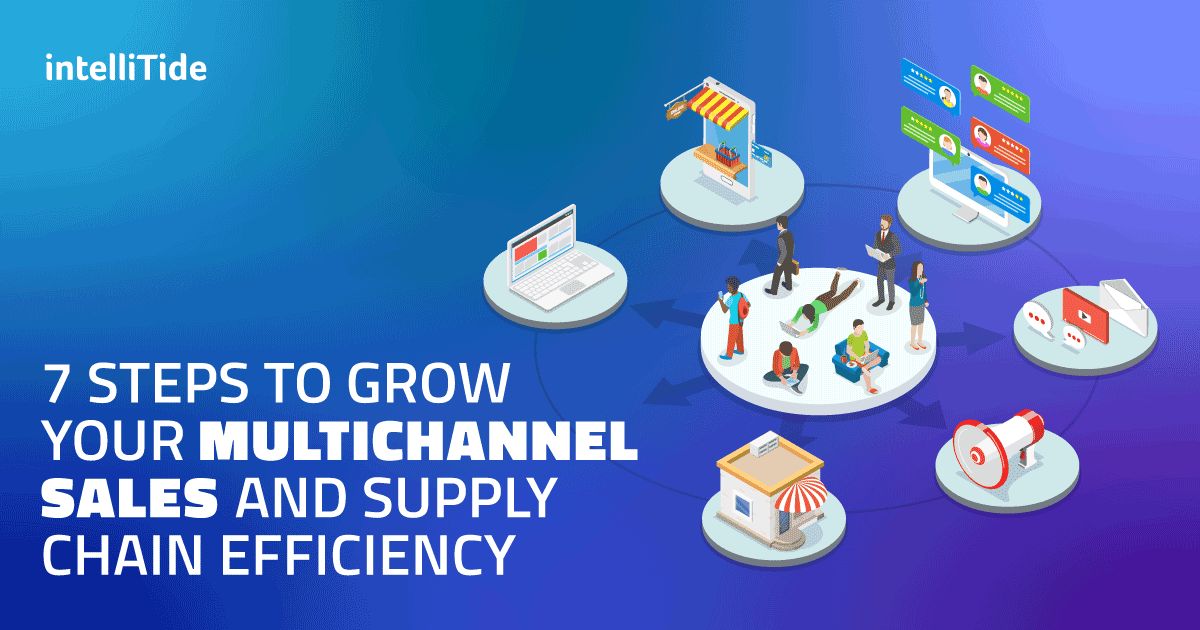7 Steps to Grow Your Multichannel Sales and Supply Chain Efficiency
To keep pace with fast-changing consumer trends, enterprises must rethink their conventional strategies and strive for greater efficiency in their supply chain operations. And that’s where the massive amounts of data generated by online, multichannel sales comes into play.
If you want to bring your products to the market quickly and grow your multichannel sales, here’s what you need to know before you begin.
1. Know your master data.
A company’s master data is its most important data asset. It encompasses several datasets, including customer, product, location, and supplier data. Master data drives business success — and better governance of this vital data leads to better profitability. That’s why it pays to invest in improving and maintaining the quality of Master Data Management (MDM).

2. Invest in online multichannel sales strategies.
By 2026, 24% of retail purchases are expected to take place online (Insider Intelligence, 2022).
By adopting a multichannel e-commerce business model, businesses can profit by selling via platforms that customers already use. Targeting multiple marketplaces (or the numerous online verticals such as Kroger or Home Depot) is a massive opportunity if you’re looking to expand and reach more buyers.
Beyond reaching new customers, selling on multiple channels has the additional benefit of quickly and accurately syndicating valuable product data.

3. Analyze multichannel sales.
Once your company is selling on multiple channels, a wealth of available customer data begins to accumulate — and it’s just waiting for you to examine it. Analyzing each channel’s sales brings answers to key business questions like:
- What is the sales performance of products by channel by month?
- What is the total revenue of products by channel for the year?
- Which pricing strategy, including promotions, had the highest and lowest impact?
- What were the top sellers by channel, time of year, customer segment and price?
- Drilling down to an individual product, how did the product perform by channel and region?

4. Improve product onboarding and accelerate go-to-market.
Marketplaces evolve quickly and so do consumer preferences. Distributors, manufacturers and retailers all feel the impact of fast-changing consumer tastes and purchasing trends.
In order to meet evolving customer preferences, companies must boost the efficiency of their go-to-market (GTM) strategy or risk falling behind. A GTM strategy involves carefully considering all the factors involved in taking a product to market — audience, marketing, distribution, pricing, positioning and sales. Essentially, it’s a roadmap for connecting with customers effectively, and establishing a thriving presence in the market.
To speed up the go-to-market (GTM) process, a company needs to promptly distribute product data across all marketing channels, including e-commerce platforms. This is part of the product onboarding process, and it’s imperative if you want rapid sales growth.

5. Examine supplier onboarding and performance.
A company’s success rests on the quality of their suppliers’ products, so it just makes sense to analyze their data to cut costs, reduce risks and drive improvement.
By measuring and monitoring a supplier’s performance frequently, it’s easier to spot problems early and
implement changes before they affect the bottom line. Focusing on performance has other benefits, such as better cooperation with suppliers, which could potentially improve how their products reach the market.
Assess the Key Performance Indicators (KPIs) that point to:
- Which vendors have the highest volume of product returns
- Which vendors have the fastest completion of the product onboarding process
- What is the fulfillment rate by each vendor

6. Merge supply chain, sales analytics and business intelligence.
While having separate data sources is okay, comprehensive, end-to-end analytics are what truly drive multichannel success. For instance, the way a supplier performs can be translated into useful data. And the way customers interact with products can also be closely tracked. So, the next step is to integrate all available data together into analytics to improve business outcomes.
With business intelligence, an enterprise can measure supplier performance, product onboarding, as well as go-to-market quality and speed, to improve their sales ROI.

7. Intersect master data and transaction data for keen business insights.
The amount of data available to companies involved in multichannel marketing is staggering; however, it’s the insights from these reams of data that boost profits as well.
Without data technology, you cannot make sales channels work together.
IntelliTide stands at the forefront of data science. With our keen understanding of enterprise-wide master and transactional data, our clients can:
- Measure and predict a product’s time-to-market
- Detect price-change patterns
- Study customer sentiment and attrition
- Evaluate price elasticity and optimization strategies
- Forecast sales and inventories
IntelliTide fuses digital transformation, data management, integration and AI to create powerful solutions and platforms. We’re here to help grow sales, save money, drive supply chain efficiency and digitally transform your company into a business that turns its data into a goldmine.

Do you have data?
We have answers. Contact us now and schedule your free 30-minute consultation, so you can begin to unlock the power of your data.
Schedule your free consultation

